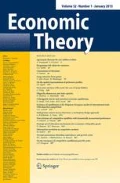Abstract
This paper describes a model where the size of the informal sector decreases as the degree to which financing contracts can be enforced in the formal sector rises. Agents who choose to operate in the informal sector can evade taxes, but they have no access to official means of contract enforcement. Numerical simulations of the model suggest that lax tax enforcement alone does not suffice to generate a large informal sector. Contractual imperfections, on the other hand, can generate a large informal sector and account for several distinguishing features of the organization of production in developing economies.
Similar content being viewed by others
References
Albuquerque R. and Hopenhayn H.A. (2004). Optimal dynamic lending contracts and firm dynamics. Rev Econ Stud 71: 285–315
Amaral, P., Quintin, E.: Financial intermediation and economic development: a quantitative assessment. Working Paper, Federal Reserve Bank of Dallas (2006a)
Amaral P. and Quintin E. (2006). A competitive model of the informal sector. J Monet Econ 53: 1541–1553
Antunes A.R. and Cavalcanti T.V. (2007). Start up costs, limited enforcement and the hidden economy. Eur Econ Rev 51: 203–224
Antunes, A.R., Cavalcanti, T.V., Villamil, A.: The effect of financial repression and enforcement on entrepreneurship and economic development. Working Paper, University of Illinois (2007)
Atkeson, A., Kehoe, P.: The transition to a new economy after the second industrial revolution. Working Paper, Federal Reserve Bank of Minneapolis (2001)
Atkeson A., Khan A. and Ohanian L. (1996). Are data on industry evolution and gross job turnover relevant for macroeconomics?. Carnegie-Rochester Conference Series on Public Policy 44: 215–250
Ayyagari, M., Beck, T., Demirgüç-Kunt, A.: Small and medium enterprises across the globe:a new database. World Bank Mimeo (2003)
Banerjee A.V. and Newman A.F. (1993). Occupational choice and the process of development. J Politi Econ 101: 274–298
Beck T., Demirgüç-Kunt A. and Levine R. (2000). A new database on financial development and structure. World Bank Econ Rev 14: 597–605
Bulow J. and Rugoff K. (1989). A constant recontracting model of sovereign debt. J Political Econ 97: 155–178
Cagetti, M., De Nardi, M.C.: Estate taxation, entrepreneurship, and wealth. Unpublished Manuscript, Federal Reserve Bank of Chicago (2007)
Cooley T., Marimon R. and Quadrini V. (2004). Aggregate consequences of limited contract enforceability. J Political Econ 112: 817–847
Fortin B., Marceau N. and Savard L. (1997). Taxation, wage controls and the informal sector. J Public Econ 66: 239–312
Guner, N., Ventura, J., Yi, X.: Macroeconomic implications of size-dependent policies. CEPR Discussion Paper 6138 (2007)
Herranz, N., Krasa, S., Villamil, A.: The impact of entrepreneur characteristics and bankruptcy rules on firm performance. Working Paper, University of Illinois (2007)
Hsieh, C.T., Klenow, P.J.: Misallocation and manufacturing TFP in China and India. Stanford University Mimeo (2006)
Johnson, S., Kaufmann, D., Shleifer, A.: The unofficial economy in transition. Brookings Papers Econ Act 159–221 (1997)
Johnson S., Kaufmann D. and Zoido-Lobaton P. (1998). Regulatory discretion and the unofficial economy. Am Econ Rev 88: 387–392
Kehoe T.J. and Levine D.K. (1993). Debt-constrained asset markets. Rev Econ Stud 60: 865–888
Kocherlakota N.R. (1996). Implications of efficient risk sharing without commitment. Rev Econ Stud 63: 595–609
Loayza N.V. (1996). The economics of the informal sector: a simple model and some empirical evidence from latin america. Carnegie-Rochester Conference Series on Public Policy 45: 129–62
Lucas R.E. (1978). On the size distribution of business firms. Bell J Econ 9: 508–523
Marcet A. and Marimon R. (1992). Communication, commitment and growth. J Econ Theory 58: 219–249
Mazumdar, D.: Size structure of manufacturing establishments and the productivity differential between large and small firms: a comparative study of Asian economies. University of Toronto Mimeo (1998)
Pratap, S., Quintin, E.: The informal sector in developing countries: output, assets and employment. UNU-WIDER Research Paper No. 2006/130 (2006)
Quintin, E.: Limited enforcement and the organization of production. Federal Reserve Bank of Dallas Mimeo (2006)
Rauch J.E. (1991). Modeling the informal sector formally. J Develop Econ 35: 33–48
Sarte P.G. (2000). Informality and rent-seeking bureaucracies in a model of long-run growth. J Monet Econ 46: 173–97
Schneider F. and Enste D.H. (2000). Shadow economies: sizes, causes and consequences. J Econ Perspect 38: 77–114
Straub S. (2005). Informal sector: the credit market channel. J Develop Econ 78: 299–321
Thomas, J.J.: Informal economic activity. LSE Handbooks in Economics (1992)
Tybout J. (2000). Manufacturing firms in developing countries: how well do they do and why?. J Econ Literat 28: 11–44
World Bank: World Development Report. Oxford University Press (1999)
World Economic Forum: The World Competitiveness Report. World Economic Forum (1994)
Author information
Authors and Affiliations
Corresponding author
Additional information
I would like to thank Tim Kehoe, Ed Prescott and Manuel Santos for their guidance, and seminar participants at ITAM, the Universidad Torcuato di Tella and the University of Montréal for their valuable comments. The views expressed herein are those of the authors and may not reflect the views of the Federal Reserve Bank of Dallas or the Federal Reserve System.
Rights and permissions
About this article
Cite this article
Quintin, E. Contract enforcement and the size of the informal economy. Econ Theory 37, 395–416 (2008). https://doi.org/10.1007/s00199-007-0295-7
Received:
Accepted:
Published:
Issue Date:
DOI: https://doi.org/10.1007/s00199-007-0295-7




